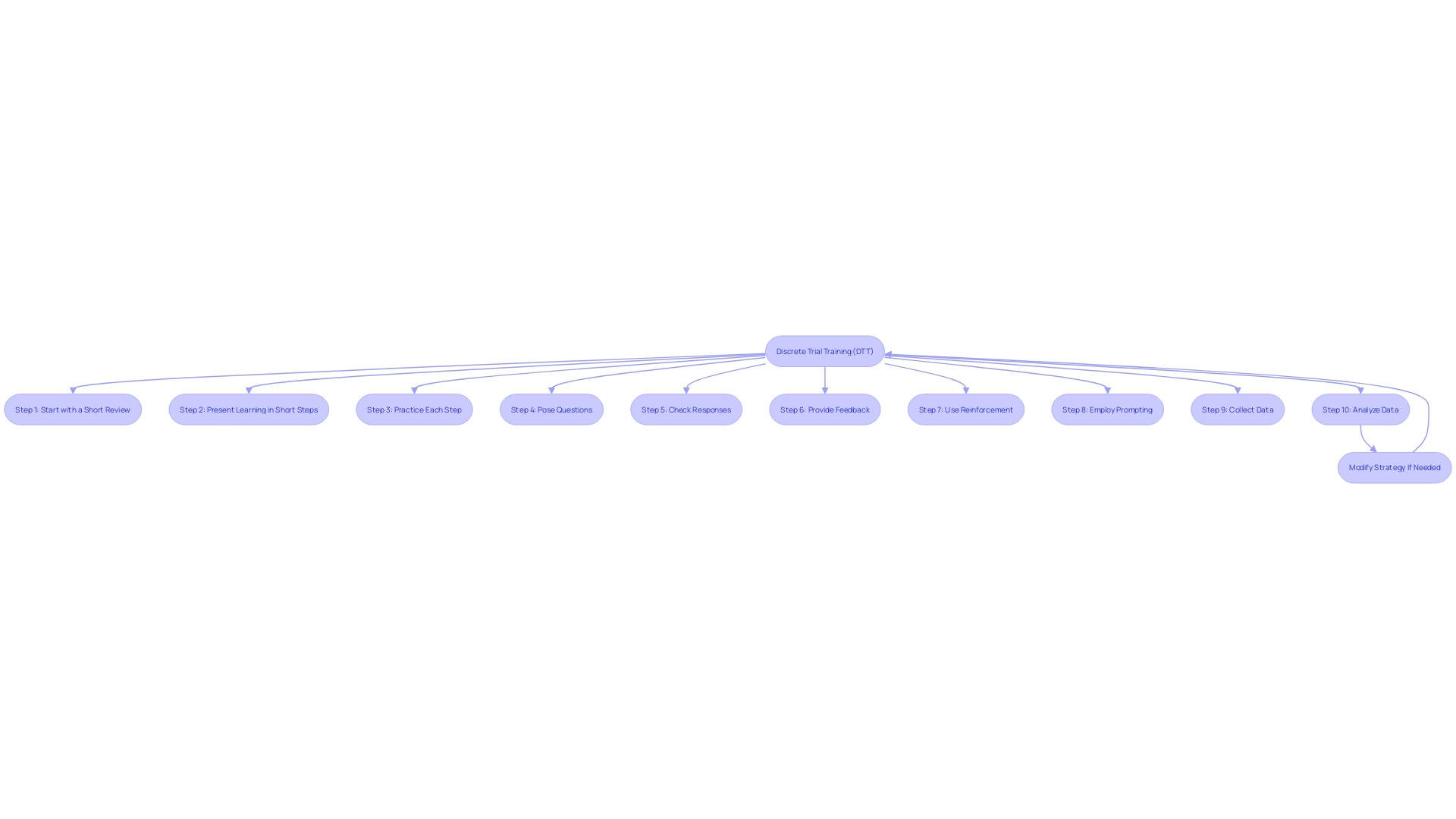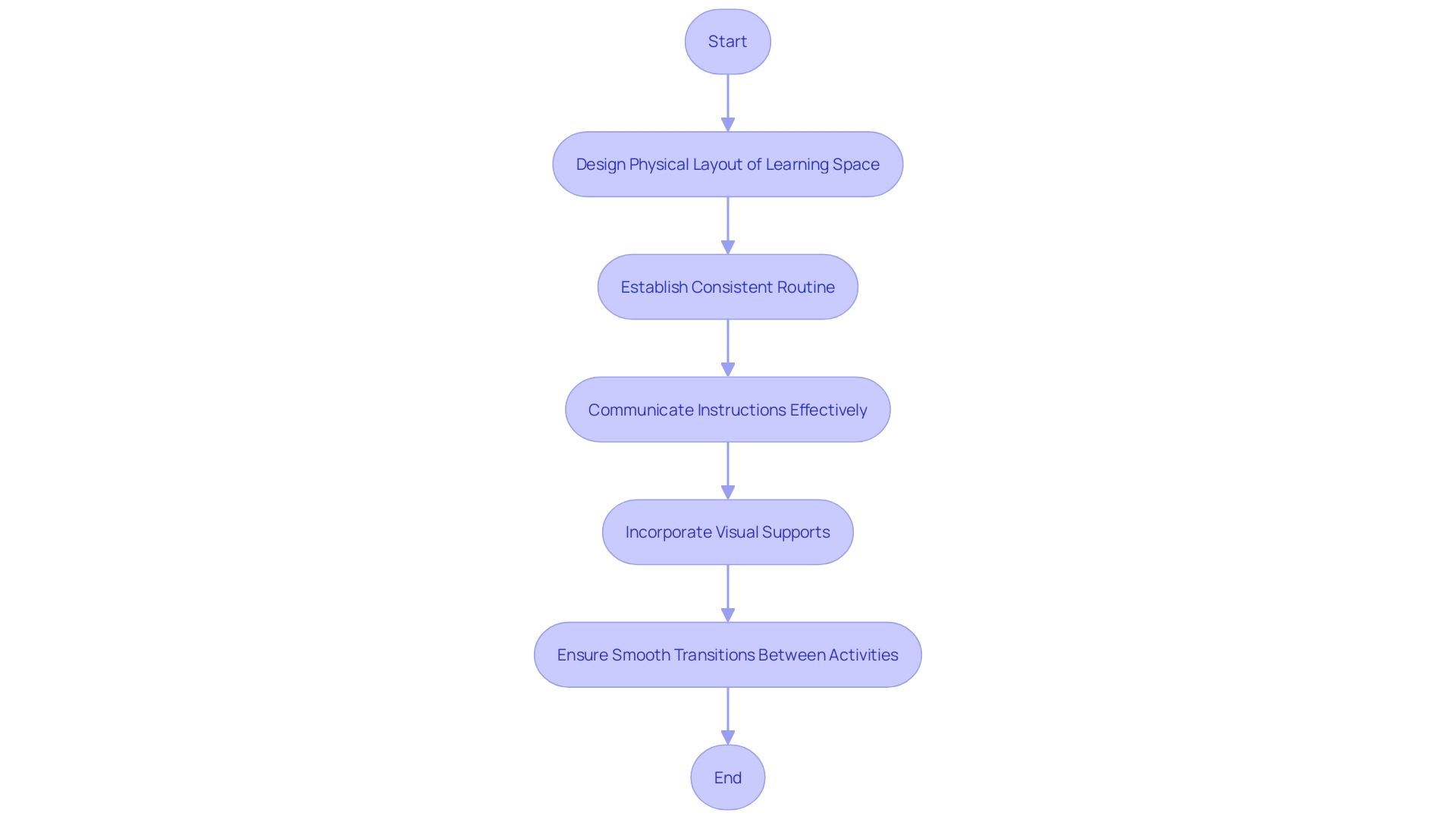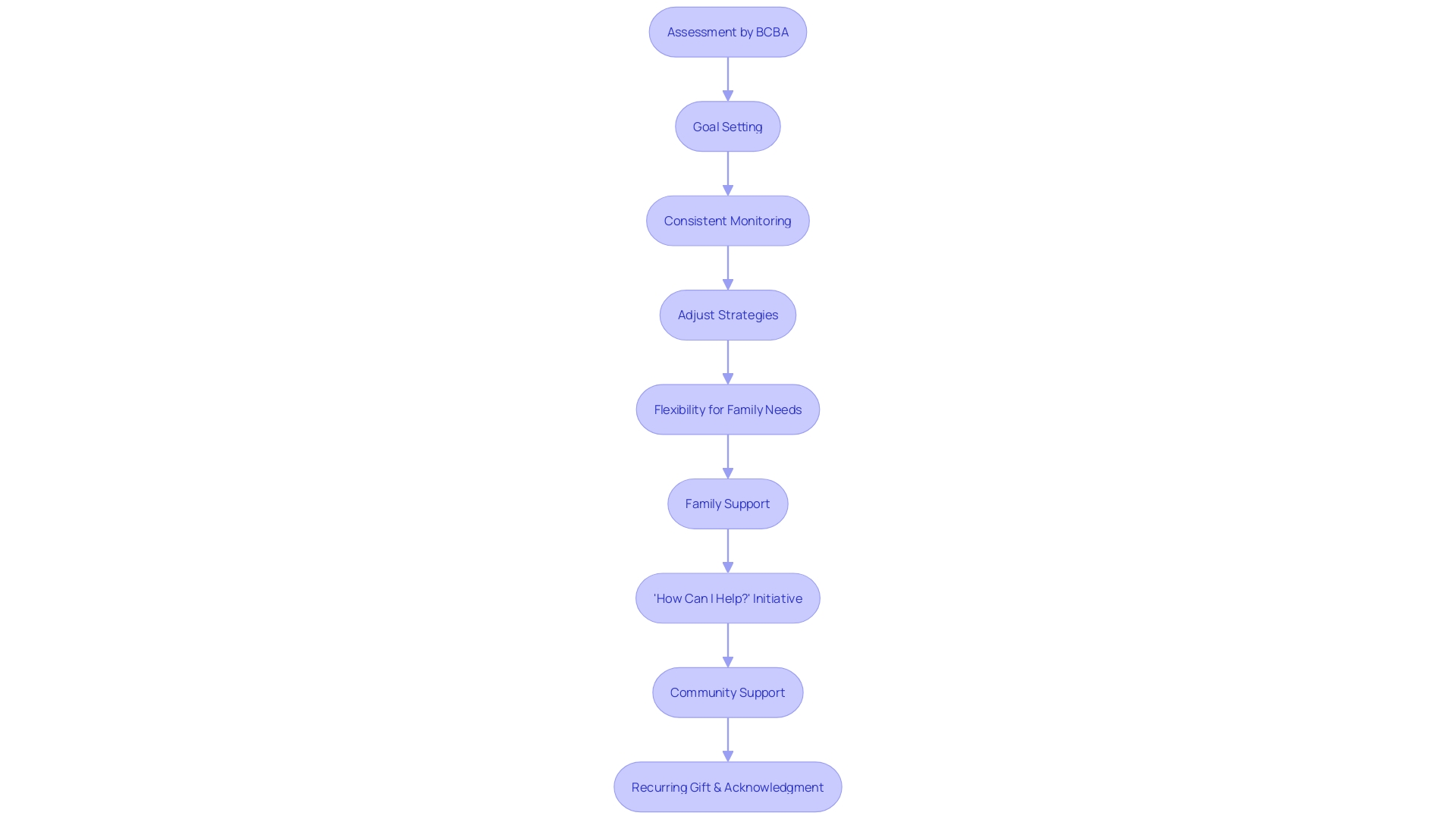Introduction
Discrete Trial Training (DTT) is a powerful method used in Applied Behavior Analysis therapy to facilitate skill development for individuals with autism. By breaking down complex skills into smaller, manageable segments, DTT empowers learners to conquer each element before moving on to the next. This structured approach, backed by rigorous research, enhances learning outcomes and promotes improved functionality in various areas of life.
DTT aligns with the goal of creating a fair and inclusive educational environment, fostering the well-being of children with autism and their families. In this article, we will explore the key principles of DTT, the importance of a structured learning environment, the components of a DTT session, and the crucial role of reinforcement in supporting learners' progress. Join us as we delve into the world of DTT and discover how it can empower individuals with autism to reach their full potential.
What is DTT?
Discrete Trial Training (DTT) plays a critical role in Applied Behavior Analysis (ABA) therapy, offering a structured framework to facilitate skill development for individuals with autism. This systematic method breaks down intricate abilities into smaller, manageable parts, allowing individuals to master each component before moving on to the subsequent one. The key to DTT's effectiveness lies in its strategic teaching techniques, which are designed to enhance learning outcomes and foster improved functionality in various life domains.
Embracing the spirit of Dr. David (Dan) R. Offord's vision, DTT ensures that each child's educational journey is equitable and that every step taken is a fair one. By tailoring teaching to individual needs and providing consistent support, DTT contributes to the engaged and peaceful participation of children with disabilities, including those who may have additional emotional and behavioral challenges.
Just as the Big "D" direct Instruction emphasizes short, systematic steps in teaching, DTT utilizes similar principles to ensure mastery and retention of skills. The success of such approaches is backed by rigorous experimental research, demonstrating positive impacts across diverse academic settings and content areas.
In fostering a fair and inclusive educational environment for children with autism, DTT aligns with the broader goal of enhancing mental health and equity, ultimately supporting the well-being of the entire family unit. Such interventions are vital in creating a society that values and uplifts the abilities and contributions of all its members, particularly those with disabilities.
Key Principles of DTT
Dissecting the core elements of Discrete Trial Training (DTT) provides vital insight into its effective application in ABA therapy. At the center of DTT are discrete trials—meticulously segmented teaching instances. Each trial encompasses a directive or prompt, the learner's reaction, and a subsequent outcome, allowing for precise tracking and assessment of the learner's advancements.
Crucially, reinforcement underpins DTT. By offering affirmative feedback or incentives, therapists aim to bolster the recurrence of beneficial behaviors or newly acquired skills. This practice not only motivates the individual but also fosters a positive learning ambiance.
Prompting is another pillar of DTT, involving various assistive signals such as verbal, visual, or physical guidance to elicit correct responses. The ultimate goal is to systematically withdraw these cues, fostering the autonomous functioning of the individual.
Underpinning all these elements is the systematic process of data collection. Accurate recording and diligent analysis of responses are indispensable for evaluating the success of interventions, pinpointing areas needing attention, and informing evidence-based adjustments in teaching strategies.

Structured Learning Environment in DTT
For children and youth with learning disabilities, including those on the autism spectrum, a well-organized learning environment is a pivotal component of effective therapy. It involves meticulously designed strategies that not only streamline the learning process but also foster an atmosphere where development can thrive.
To begin with, the physical layout of the learning space is paramount. It should be organized to minimize distractions and maximize concentration, enabling individuals to focus on the tasks at hand. Visual aids play a significant role here; they can range from visual schedules that outline the day's activities to task boards that break down complex tasks into manageable steps, guiding individuals through their educational journey.
Establishing a consistent routine is another cornerstone of a structured learning environment. This not only ensures a feeling of safety and consistency, but it also enables the precise evaluation of advancement, which is crucial for customizing the treatment according to the individual's requirements.
Communicating instructions effectively is just as crucial. They must be clear, concise, and, if necessary, broken down into smaller steps. This method reduces ambiguity and assists individuals in comprehending precisely what is required of them, thereby improving the efficiency of the treatment.
Incorporating visual supports such as prompts or timers can significantly aid comprehension and promote independence. These tools provide a visual reference that can help clarify expectations and make abstract concepts more concrete.
Finally, smooth transitions between activities are vital for maintaining the flow of the session and reducing potential stress. Methods such as offering transition cues or warnings prior to modifications can assist in preparing individuals for the next task, thereby facilitating their transition from one activity to another.
By implementing these strategies, parents and therapists can establish a learning environment that not only supports the distinct requirements of individuals with disabilities but also empowers them to reach their maximum capabilities.

Components of a DTT Session
A Discrete Trial Training (DTT) session, a key component of ABA therapy, involves a structured sequence of steps designed to teach and reinforce desired actions. It starts with a Discriminative Stimulus (SD), which is essentially an instruction or prompt that signals what response is anticipated. The Reply of the student comes next, which can be spoken, done physically, or another form of suitable action that the SD caused. The third step is the Consequence, immediate feedback based on the individual's action. This feedback could be positive reinforcement if the response was correct, or corrective feedback to guide the individual towards the correct behavior.
During the session, Data Collection is vital. It involves recording the student's responses to track progress and inform future teaching strategies. This data collection is akin to the work of researchers who emphasize the importance of data to expand the reach and impact of evidence-based practices. For instance, the Speech Accessibility Project's goal to make speech technology more accessible hinges on proper data use and the transparency of research findings, reflecting a broader principle of responsible data handling.
Lastly, Reinforcement is provided contingent on the individual's performance. This could include verbal praise, tokens, or access to preferred activities. The philosophy behind reinforcement resonates with the idea of creating equitable conditions, as underscored by child psychiatrist Dr. David R. Offord, where all children, including those with disabilities, are supported in a manner that ensures a 'fair race' in their development.
The practice of DTT emphasizes the crucial role of data in shaping effective interventions and supporting students, reflecting the careful consideration of data's role in broader educational and technological contexts. It's a reminder that, while data can guide decision-making, it's the human-centric application that makes the difference in both individual learning and societal advancements.

The Role of Reinforcement in DTT
Reinforcement is a cornerstone of Discrete Trial Training (DTT), instrumental in encouraging learners to acquire and retain new skills and actions. There are several facets of reinforcement in DTT that are crucial for its effectiveness:
- Positive and Negative Reinforcement: Positive reinforcement involves presenting a stimulus, like a reward or a favorite activity, after a desired behavior is performed, thereby increasing the likelihood of the behavior being repeated. In contrast, negative encouragement occurs when an undesirable stimulus is removed following a behavior, which also increases the likelihood of the behavior's recurrence.
It's crucial to determine what kind of support is most effective for each individual, which can differ greatly. This personalization can be achieved through careful observation, conducting preference assessments, or receiving direct feedback from the learner themselves.
- Scheduling Strengthening: The timing and frequency of strengthening are strategically planned through schedules. Consistent support is advantageous when instructing a fresh action, reinforcing every accurate reaction, while sporadic reward—given after a fixed quantity of reactions or period of time—can assist in preserving established actions.
As individuals become more proficient at the action or ability, it's crucial to gradually decrease the frequency of reward. This procedure assists individuals in sustaining the conduct autonomously and promotes the transfer of abilities to different settings and circumstances.
These strategies ensure that reinforcement is optimized to support the learner's progress and the overall goals of DTT, leading to more effective learning outcomes and the empowerment of individuals with disabilities to participate more fully in their daily lives.
Conclusion
In conclusion, Discrete Trial Training (DTT) is a powerful method used in Applied Behavior Analysis therapy to support the skill development of individuals with autism. DTT breaks down complex skills into manageable segments, empowering learners to conquer each element before progressing. This structured approach enhances learning outcomes and promotes improved functionality.
The key principles of DTT include discrete trials, reinforcement, prompting, and systematic data collection. Discrete trials track learners' advancements, while reinforcement motivates and creates a positive learning environment. Prompting assists learners in achieving correct responses, promoting independence.
Systematic data collection evaluates interventions and informs adjustments.
A well-structured learning environment is essential for effective therapy. This involves minimizing distractions, establishing routines, communicating clear instructions, using visual supports, and ensuring smooth transitions. These strategies support the unique needs of learners with disabilities and empower them to reach their full potential.
During a DTT session, a structured sequence of steps is followed, including a discriminative stimulus, the learner's response, and the consequence. Data collection tracks progress, while reinforcement is provided based on performance. DTT emphasizes the critical role of data and human-centric application in learning and societal advancements.
Reinforcement is a cornerstone of DTT, involving positive and negative reinforcement, tailoring to the individual, scheduling, and fading. These strategies optimize reinforcement to support learners' progress and empower individuals with disabilities.
In summary, DTT offers a structured and effective approach to skill development for individuals with autism. By implementing the key principles, creating a well-structured learning environment, and utilizing reinforcement strategies, learners can reach their full potential and promote overall well-being.




